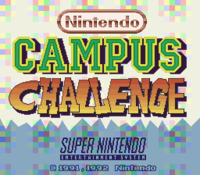Nintendo Campus Challenge: Difference between revisions
m (→See also) Tag: Mobile edit |
No edit summary Tag: Mobile edit |
||
| Line 1: | Line 1: | ||
[[File:Nintendo Campus Challenge 1991 cartridge.jpg|thumb|A cartridge used at the 1991 Nintendo Campus Challenge]] | [[File:Nintendo Campus Challenge 1991 cartridge.jpg|thumb|A cartridge used at the 1991 Nintendo Campus Challenge]] | ||
__NOTOC__ | __NOTOC__ | ||
''' | The '''{{wp|Nintendo Campus Challenge}}''' was a video game competition that was sponsored by [[Nintendo]]. The competition occurred in 1991 and 1992. There are two different cartridges produced for each event: a [[Nintendo Entertainment System]] version for the 1991 competition, and a [[Super Nintendo Entertainment System]] cartridge for the 1992 competition. A special cartridge of the 1991 competition titled ''Nintendo Campus Challenge'' is considered to be even rarer than the [[Nintendo World Championships]] cartridge with only one known to exist. It was sold on eBay for $20,100<ref>Guinness World Records, pg. 121{{better source}}</ref> and is currently owned by a private collector. | ||
==Games== | ==Games== | ||
===NES version=== | ===NES version=== | ||
The NES game was used in the 1991 Nintendo Campus Challenge that toured | The NES game was used in the 1991 Nintendo Campus Challenge that toured 50 cities. The top prize was an all-expense trip to Florida for the next tournament, which took place in 1992. | ||
The NES game is a combination of ''[[Super Mario Bros. 3]]'', ''{{wp|Pinbot}}'' and ''[[Dr. Mario (game)|Dr. Mario]]''. In ''Super Mario Bros. 3'', the player must collect 25 | The NES game is a combination of ''[[Super Mario Bros. 3]]'', ''{{wp|Pinbot}}'', and ''[[Dr. Mario (game)|Dr. Mario]]''. In ''Super Mario Bros. 3'', the player must collect 25 [[coin]]s. In ''Pinbot'', the player must reach 100,000 points. Finally, in ''Dr. Mario'', the player must score as high as possible. It is unknown whether ''Pinbot'' or ''Dr. Mario'' was modified, but it is known that ''Super Mario Bros. 3'' was. After the allotted time ends, the player's scores are totaled; their score from ''Super Mario Bros. 3'' is multiplied by ten, and the score from ''Dr. Mario'' is multiplied by 100. | ||
===SNES version=== | ===SNES version=== | ||
[[File:NCCTitleScreen.png|thumb|left|Title screen for the Super Nintendo version]] | [[File:NCCTitleScreen.png|thumb|left|Title screen for the Super Nintendo version]] | ||
[[File:NCTitleScreen.png|thumb|Title screen for the Super Nintendo version]] | [[File:NCTitleScreen.png|thumb|Title screen for the Super Nintendo version]] | ||
In 1992, the Nintendo Campus Challenge visited | In 1992, the Nintendo Campus Challenge visited 35 different campuses, including {{wp|Central Michigan University}}, {{wp|Arizona State University}}, and {{wp|Texas A & M University}}. This version of the game was a combination of ''[[Super Mario World]]'', ''[[fzerowiki:F-Zero|F-Zero]]'', and ''{{wp|Pilotwings}}''. Like the NES game, it too was modified. In ''Super Mario World'', players are required to get 50 coins. In ''F-Zero'', players are required to complete two laps with the vehicle of their choosing. In ''Pilotwings'', players are required to parachute from two planes and land on a certain target. While the ''Super Mario World'' score was unadjusted, simply being the player's overall score at the time of completing the challenge, the ''F-Zero'' score was multiplied by 100, and the ''Pilotwings'' score was multiplied by 10,000. | ||
The first place winner at each university received a Super Nintendo Entertainment System and full retail copies of the three games included in the challenge, while | The first-place winner at each university received a Super Nintendo Entertainment System and full retail copies of the three games included in the challenge, while second-, third-, and fourth-place winners got $100, $75, and $50, respectively. The grand prize winner received $10,000. | ||
{{br}} | {{br}} | ||
| Line 34: | Line 33: | ||
<references/> | <references/> | ||
{{NES}} | {{NES}} | ||
{{Game competitions}} | {{Game competitions}} | ||
Revision as of 11:20, October 18, 2023
The Nintendo Campus Challenge was a video game competition that was sponsored by Nintendo. The competition occurred in 1991 and 1992. There are two different cartridges produced for each event: a Nintendo Entertainment System version for the 1991 competition, and a Super Nintendo Entertainment System cartridge for the 1992 competition. A special cartridge of the 1991 competition titled Nintendo Campus Challenge is considered to be even rarer than the Nintendo World Championships cartridge with only one known to exist. It was sold on eBay for $20,100[1] and is currently owned by a private collector.
Games
NES version
The NES game was used in the 1991 Nintendo Campus Challenge that toured 50 cities. The top prize was an all-expense trip to Florida for the next tournament, which took place in 1992.
The NES game is a combination of Super Mario Bros. 3, Pinbot, and Dr. Mario. In Super Mario Bros. 3, the player must collect 25 coins. In Pinbot, the player must reach 100,000 points. Finally, in Dr. Mario, the player must score as high as possible. It is unknown whether Pinbot or Dr. Mario was modified, but it is known that Super Mario Bros. 3 was. After the allotted time ends, the player's scores are totaled; their score from Super Mario Bros. 3 is multiplied by ten, and the score from Dr. Mario is multiplied by 100.
SNES version
In 1992, the Nintendo Campus Challenge visited 35 different campuses, including Central Michigan University, Arizona State University, and Texas A & M University. This version of the game was a combination of Super Mario World, F-Zero, and Pilotwings. Like the NES game, it too was modified. In Super Mario World, players are required to get 50 coins. In F-Zero, players are required to complete two laps with the vehicle of their choosing. In Pilotwings, players are required to parachute from two planes and land on a certain target. While the Super Mario World score was unadjusted, simply being the player's overall score at the time of completing the challenge, the F-Zero score was multiplied by 100, and the Pilotwings score was multiplied by 10,000.
The first-place winner at each university received a Super Nintendo Entertainment System and full retail copies of the three games included in the challenge, while second-, third-, and fourth-place winners got $100, $75, and $50, respectively. The grand prize winner received $10,000.
Gallery
See also
External links
References
- ^ Guinness World Records, pg. 121[better source needed]



